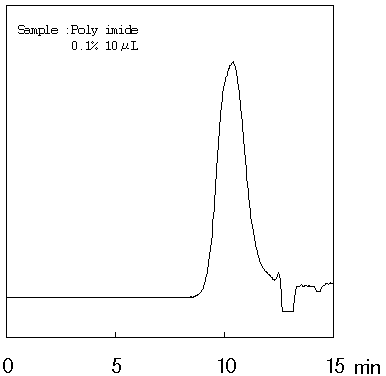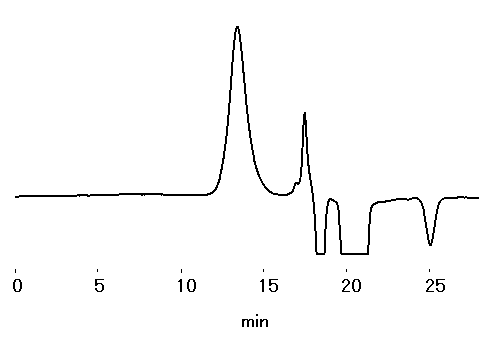Hydrophobic Polymers: Other Eluents
Polystyrene standards were analyzed using GPC KF-802 and KF-806M (columns for organic SEC (GPC)).
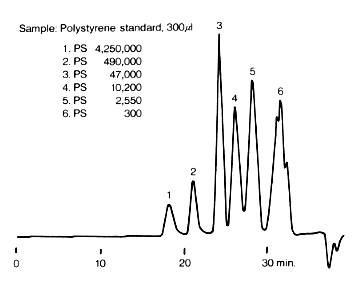
Sample :
1. PS, Polystyrene (MW: 4,250,000)
2. PS, Polystyrene (MW: 490,000)
3. PS, Polystyrene (MW: 47,000)
4. PS, Polystyrene (MW: 10,200)
5. PS, Polystyrene (MW: 2,550)
6. PS, Polystyrene (MW: 300)
Columns : Shodex GPC KF-806M x 2 + KF-802 (8.0mmID*300mm each) Eluent : Toluene Flow rate : 1.0mL/min Detector : Shodex RI Column temp. : Room temp.
Silicone oil was analyzed using GPC K-806M (a column for organic SEC (GPC)). For polymers such as silicone oil, which does not have UV absorption and small differences in refractive index with THF or chloroform, neither THF eluent nor chloroform eluent can be used. For the RI detection of silicone oil, therefore, toluene whose refractive index is significantly larger than that of silicone oil should be used as an eluent. Since the refractive index of silicone oil is smaller than that of toluene, negative peaks will appear when the detector polarity is normal position. Therefore, it is advisable to use reversed polarity to obtain positive peaks. Methylphenyl silicone oil which has UV absorption can be detected by UV detector with THF eluent.
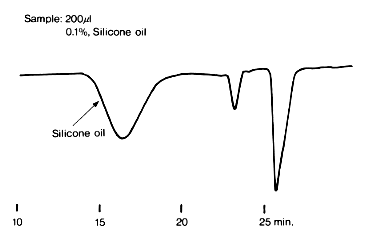
Sample : silicone oil
Columns : Shodex GPC K-806M (8.0mmID*300mm) x 2 Eluent : Toluene Flow rate : 1.0mL/min Detector : Shodex RI Column temp. : 45deg-C
Dimethyl silicone oil was analyzed using GPC KF-802 and KF-806M (a column for organic SEC (GPC)).
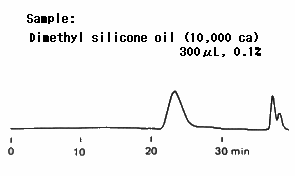
Sample : Dimethyl silicone oil
Columns : Shodex GPC KF-806M x 2 + KF-802 (8.0mmID*300mm each) Eluent : Toluene Flow rate : 1.0mL/min Detector : Shodex RI(polarity: -) Column temp. : Room temp.
Natural rubber was analyzed using GPC KF-802 and KF-806M (columns for organic SEC (GPC)). Since natural rubber is easily dissolved in toluene, toluene eluent is used for GPC analysis of this sample.

Sample : Rubber
Columns : Shodex GPC KF-806M x 2 + KF-802 (8.0mmID*300mm each) Eluent : Toluene Flow rate : 1.0mL/min Detector : Shodex RI Column temp. : Room temp.
Polydimethylsiloxane was analyzed using GPC KF-606, KF-604 and KF-603, downsized organic SEC (GPC) Columns.
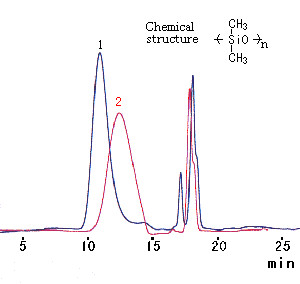
Sample : Polydimethylsiloxane
1. visco.=10,000
2. visco.=350
Columns : Shodex GPC KF-606 + KF-604 + KF-603 (6.0mmID*150mm each) Eluent : Toluene Flow rate : 0.6mL/min Detector : Shodex RI(small cell volume) Polarity: (-) Column temp. : 40deg-C
Polystyrene standards were analyzed using GPC KF-806L (a column for organic SEC (GPC)).

Sample :
1. PS, Polystyrene (MW: 4,250,000)
2. PS, Polystyrene (MW: 410,000)
3. PS, Polystyrene (MW: 87,000)
4. PS, Polystyrene (MW: 10,200)
5. PS, Polystyrene (MW: 1,350)
Column : Shodex GPC KF-806L (8.0mmID*300mm) Eluent : Dimethylacetamide(DMAc) Flow rate : 1.0mL/min Detector : Shodex RI Column temp. : 40deg-C
Polystyrene standards were analyzed using GPC KF-806L (a column for organic SEC (GPC)).

Sample :
1. PS, Polystyrene (MW: 4,250,000)
2. PS, Polystyrene (MW: 410,000)
3. PS, Polystyrene (MW: 87,000)
4. PS, Polystyrene (MW: 10,200)
5. PS, Polystyrene (MW: 1,350)
Column : Shodex GPC KF-806L (8.0mmID*300mm) Eluent : NMP Flow rate : 1.0mL/min Detector : Shodex RI Column temp. : 40deg-C
Poly(-N,N-dimethylaminomethylstyrene) is a basic polmer which has basic dissociation groups. The effect of eluent composition is shown below:
Eluent a)——This eluent is a typical one for polymer analysis, however, this eluent is not good for this polymer. The polymer is adsorbed by the packing materials and will not elute because dissociation of amino groups in the polymer is suppressed.
Eluent b)——By the addition of chloroform, the polarity of the eluent is lowered and the adsorption problem by the packing materials is apparently solved. However, comparing the calibration curve of polystyrene of the eluent b) with that of THF, it is confirmed that some amount of adsorption still exists.
Eluent c)——N-methylpyrolidon (NMP) which is commonly used for the analysis of high polarity polymers is used as the eluent. To cancel ionic interaction between NMP and sample, LiBr is added, and, to suppress dissociation of sample, ethylenediamine is added. The obtained GPC pattern is very good and free from hydrophobic adsorption and ionic interaction.
As described in the above, not only the selection of column type but also the selection of eluent composition is very important for the analysis of ionic polymers. GPC KD-800 series are suited to the polar substances which are dissolved in polar solvents such as DMF, DMAc, NMP and ethylacetate.

Sample: Poly(-N,N-dimethyl aminomethyl styrene)
Columns : Shodex GPC KD-804 + KD-803 (8.0mmID*300mm each)
Eluent : a) 5mM LiBr in DMF
b) 5mM LiBr in DMF/CHCl3=50/50
c) (5mM LiBr + 50mM Ethylenediamine) in NMP
Flow rate : 1.0mL/min
Detector : Shodex RI
Column temp. : Room temp.
Poly(vinylpyrrolidone) (PVP) were analyzed using GPC KF-606M, a downsized organic SEC (GPC) Column.
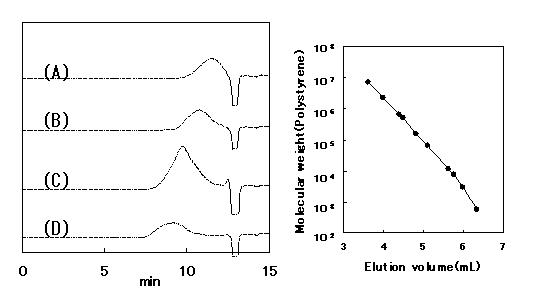
Sample : Poly(vinylpyrrolidone) (PVP) 0.1%, 10micro-L
(A) PVP (K 15)
(B) PVP (K 30)
(C) PVP (K 60)
(D) PVP (K 90)
Columns : Shodex GPC KF-606M (6.0mmID*150mm) x 2 Eluent : 0.01M LiBr in NMP Flow rate : 0.5mL/min Detector : Shodex RI(small cell volume) Column temp. : 60deg-C
N-methoxymethyl nylon was analyzed using Asahipak GF-710 HQ. N-methoxymethyl nylon, which is obtained by denaturing 6-nylon, is alcohol -soluble. Methanol is used as an eluent containing 50mM LiCl. The addition of LiCl to methanol is very important to prevent sample adsorption by the packing material and to get an accurate measurement. Poly(ethylene glycol) (PEG) and poly(ethylene oxide) (PEO) are used as calibration standards for GPC analysis with methanol eluent.

Sample : N-Methoxymethyl nylon, Polyamide
Columns : Shodex Asahipak GF-710 HQ (7.5mmID*300mm) x 2 Eluent : 50mM LiCl in CH3OH Flow rate : 0.5mL/min Detector : Shodex RI Column temp. : 30deg-C
Melamine formaldehyde resin were analyzed using Asahipak GS-310 7G. In some cases, a mixture of two solvents, with different hydrophobicities, is used as an eluent. When the structure or the characteristics of the sample are complicated, it is useful to use such mixed-solvent eluent. Melamine formaldehyde resin is analyzed by using a chloroform/methanol eluent. The sample interacts with the packing material, when an eluent such as just chloroform or methanol is used. Therefore, this sample cannot be eluted by GPC mode. When a chloroform/methanol(80/20) eluent is used, however, the interaction disappears and the elution by GPC mode can take place.
GS-310 7G is an old type of GF-310 HQ.


Sample : Melamine formaldehyde resin
Column : Shodex Asahipak GS-310 7G (7.5mmID*500mm) Eluent : CHCl3/CH3OH Flow rate : 0.5mL/min Detector : UV(254nm)
S. Mori, J. Liq. Chromatogr. 11 (6) (1988) 1205
p-Cresol formaldehyde resol resin was analyzed using Asahipak GS-310 7G.
GS-310 7G is an old type of GF-310 HQ.

Sample : p-Cresol formaldehyde resol resin
Column : Shodex Asahipak GS-310 7G (7.5mmID*500mm) Eluent : CHCl3/CH3OH Flow rate : 0.5mL/min Detector : UV(254nm)
S. Mori, J. Liq. Chromatogr. 11 (6) (1988) 1205
Phenol formaldehyde novolac resin was analyzed using Asahipak GS-310 7G.
GS-310 7G is an old type of GF-310 HQ.
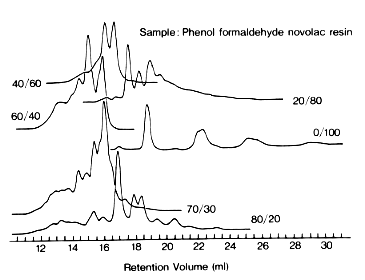
Sample : Phenol formaldehyde novolac resin
Column : Shodex Asahipak GS-310 7G (7.5mmID*500mm) Eluent : CHCl3/CH3OH Flow rate : 0.5mL/min Detector : UV(254nm)
S. Mori, J. Liq. Chromatogr. 11 (6) (1988) 1205.
Polyamic acid was analyzed using organic solvent SEC (GPC) column, GPC LF-804. Polyamic acid is a precursor of polyimide. It is a multi-ionic polymer which contains positive and negative electric charges. Here, analysis under two different mobile phases were compared: (1) NMP alone and (2) with LiBr and phosphoric acid added to NMP. By adding LiBr and phosphoric acid, ionic interactions was suppressed and this resulted in producing better (sharper) peak shape.

Sample : Polyamic acid, Poly(pyromellitic dianhydride-co-4,4′-oxydianiline), 100micro-L
Columns : Shodex GPC LF-804 (8.0mmID*300mm) x 2 Eluent : (30mM LiBr + 30mM H3PO4) in NMP (upper), NMP (lower) Flow rate : 0.7mL/min Detector : Shodex RI Column temp. : 50deg-C
Organic solvent SEC (GPC) column, GPC LF-804 was used to analyze polyamic acid.

Sample : Polyamic acid, Poly(3,3′,4,4′-biphenyltetracarboxylic dianhydride-co-1,4-phenylenediamine), 100micro-L
Columns : Shodex GPC LF-804 (8.0mmID*300mm) x 2 Eluent : (30mM LiBr + 30mM H3PO4) in NMP Flow rate : 0.7mL/min Detector : Shodex RI Column temp. : 50deg-C
Organic solvent SEC (GPC) column, GPC LF-804 was used to analyze polyamic acid.
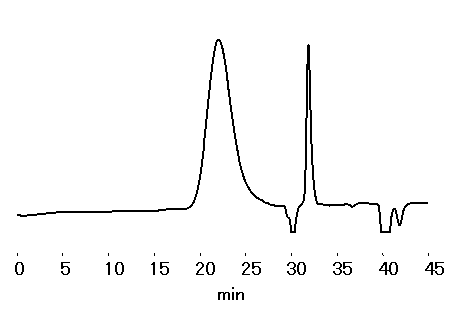
Sample : 100micro-L
Polyamic acid, Poly(3,3′,4,4′-benzophenonetetracarboxylic dianhydride-co-4,4′-oxydianiline/1,3-phenylenediamine)
Columns : Shodex GPC LF-804 (8.0mmID*300mm) x 2 Eluent : (30mM LiBr + 30mM H3PO4) in NMP Flow rate : 0.7mL/min Detector : Shodex RI Column temp. : 50deg-C
Organic solvent SEC (GPC) column, GPC KD-806M was used to analyze cellulose. Sample preparation (to dissolve cellulose into solvent) is highly dependent on the type of solvent and characteristics of the sample (crystallization, MW). Some may take up to 60 days for the preparation.
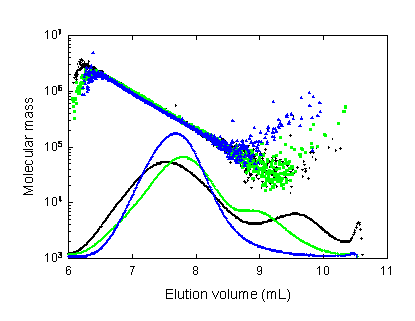
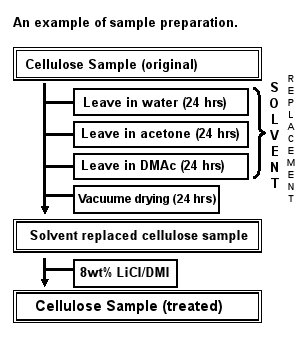
Sample : Cellulose ca. 0.05% each, 100micro-L
Column : Shodex GPC KD-806M (8.0mmID*300mm) Eluent : 1% LiCl in *DMI Flow rate : 0.5mL/min Detector : MALS(Multi Angle Laser Light Scattering), RI Column temp. : 60deg-C * 1,3-dimethyl-2-imidazolidinone
Data provided by Dr. Masahiko Yanagisawa, Isogai group, Graduate School of Agricultural and Life Sciences, The University of Tokyo

